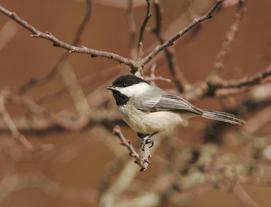BLACK-CAPPED CHICKADEE OR-359
Willamette Valley, William L. Finley National Wildlife Refuge, Oregon
May 24, 5:21 a.m.
Sunrise at 5:36 a.m.
I've biked over 4000 miles from the Atlantic Ocean to hear this special dialect of the black-capped chickadee, as I remember it well from over 30 years ago.
One of the songs (A) in this dialect is a cascade of lengthening whistles, as in the first song (at 0:02). Over eight whistled notes, he begins with a tiny whistle just 3/100th of a second long and finishes with a whistle five times longer (16/100th of a second), dropping gradually from about 4700 Hz down to 4000 Hz.
Another song (B) has several whistles held on a lower, steady pitch, at about 3700 Hz; the second song here (at 0:06) is just as I remember it, with four whistles of roughly equal length (though they do lengthen slightly over the duration of the song).
The third song here is yet another one (C) from the chickadees who sing this Willamette Valley dialect. It's somewhat like B, in that the whistles are held on a steady pitch (though the first drops slightly), but the frequency is higher (about 4000 Hz) and the whistles somewhat longer (about 0.20 seconds here, at most 0.15 in song B).
Once I've grasped the essence of the three different songs, I can wallow in the larger performance. Minute by minute, his song sequence is as follows:
A B C B C A A A B A C A C A
B C A A C A C C A C C C C A C C
C C A C C C C C A B C A
C A B A A B B C B B B
B A B A A C B A B A C A C A
C C A A A A C . . .
How remarkably different this dialect is from the hey-sweetie dialect wherever these chickadees occur in North America. In that larger dialect, the hey-sweetie song was transposed over a range of frequencies, in essence generating a large variety of songs (differing only in frequency) with which the males could countersing and play whatever games they play. In this dialect, the males don't seem to transpose their songs, but instead just have three strikingly different songs.
One more thing. Hear how the chickadee's second song overlaps with that of the towhee at 0:06? After that, for the remaining 72 chickadee songs, hear how the towhee and chickadee mostly take turns singing, so that they don't interfere with each other.
Surprisingly the towhee seems to sing the same song throughout, even though this is the dawn chorus and others of his kind are hustling through their different songs more rapidly.
Background
Common yellowthroat, spotted towhee, Swainson's thrush, song sparrow, pied-billed grebe (0:48), black-headed grosbeak, tree swallow, chipping sparrow, Steller's jay (shook shook shook shook at 4:55), orange-crowned warbler.

Photo by John Van de Graaff
